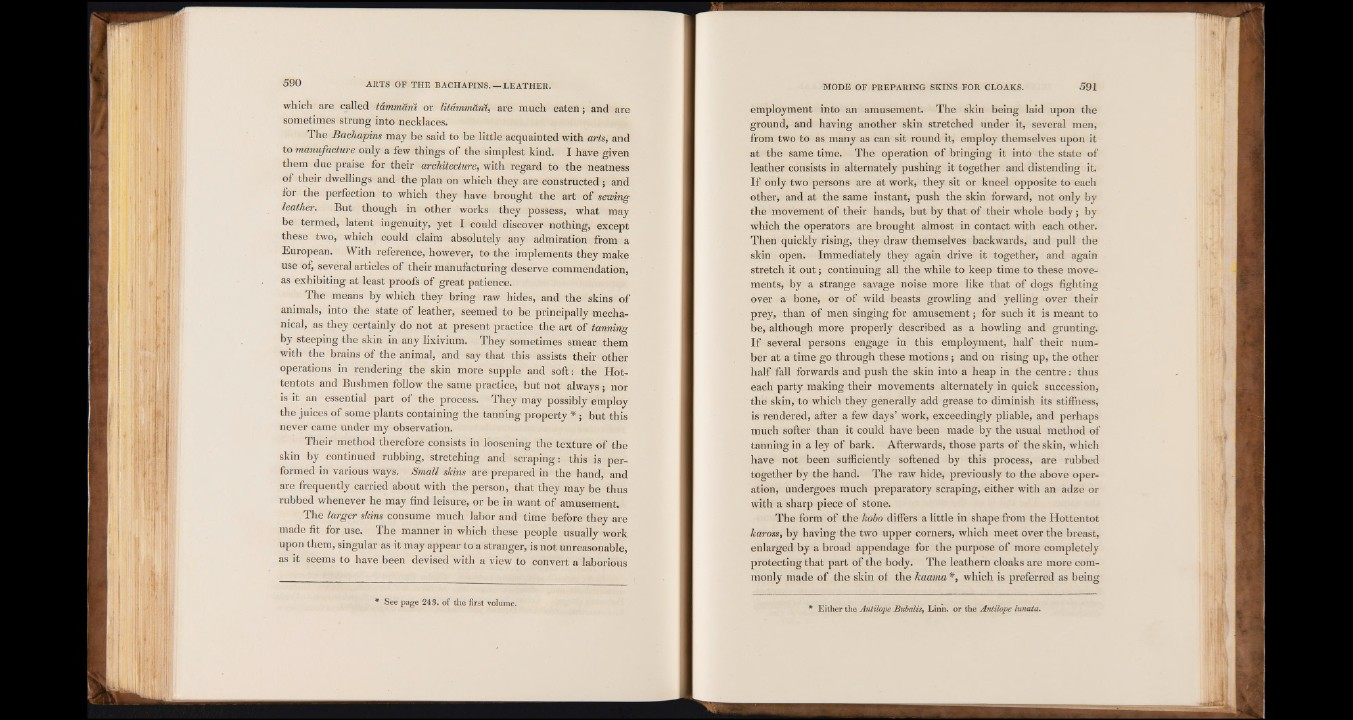
which are called tammtim or litdmmitrii, are much eaten; and are
sometimes strung into necklaces.
The Bachapins may be said to be little acquainted with arts, and
to manufacture only a few things of the simplest kind. I have given
them due praise for their architecture, with regard to the neatness
of their dwellings and the plan on which they are constructed; and
for the perfection to which they have brought the art of sewing
leather. But though in other works they possess, what may
be termed, latent ingenuity, yet I could discover nothing, except
these two, which could claim absolutely any admiration from a
European. With reference, however, to the implements they make
use of, several articles of their manufacturing deserve commendation,
as exhibiting at least proofs of great patience.
The means by which they bring raw hides, and the skins of
animals, into the state of leather, seemed to be principally mechanical,
as they certainly do not at present practice the art of tanning
by steeping the skin in any lixivium. They sometimes smear them
with the brains of the animal, and say that this assists their other
operations in rendering the skin more supple and soft: the Hottentots
and Bushmen follow the same practice, but not always ; nor
is it an essential part of the process. They may possibly employ
the juices of some plants containing the tanning property *; but this
never came under my observation.
Their method therefore consists in loosening the texture of the
skin by continued rubbing, stretching and scraping: this is performed
in various ways. Small skins are prepared in the hand, and
are frequently carried about with the person, that they may be thus
rubbed whenever he may find leisure, or be in want of amusement.
The larger skins consume much labor and time before they are
made fit for use. The manner in which these people usually work
upon them, singular as it may appear to a stranger, is not unreasonable,
as it seems to have been devised with a view to convert a laborious
employment into an amusement. The skin being laid upon the
ground, and having another skin stretched under it, several men,
from two to as many as can sit round it, employ themselves upon it
at the same time. The operation of bringing it into the state of
leather consists in alternately pushing it together and distending it.
If only two persons are at work, they sit or kneel opposite to each
other, and at the same instant, push the skin forward, not only by
the movement of their hands, but by that of their whole body ; by
which the operators are brought almost in contact with each other.
Then quickly rising, they draw themselves backwards, and pull the
skin open. Immediately they again drive it together, and again
stretch it out; continuing all the while to keep time to these movements,
by a strange savage noise more like that of dogs fighting
over a bone, or of wild beasts growling and yelling over their
prey, than of men singing for amusement; for such it is meant to
be, although more properly described as a howling and grunting.
If several persons engage in this employment, half their number
at a time go through these motions; and on rising up, the other
half fall forwards and push the skin into a heap in the centre: thus
each party making their movements alternately in quick succession,
the skin, to which they generally add grease to diminish its stiffness,
is rendered, after a few days’ work, exceedingly pliable, and perhaps
much softer than it could have been made by the usual method of
tanning in a ley of bark. Afterwards, those parts of the skin, which
have not been sufficiently softened by this process, are rubbed
together by the hand. The raw hide, previously to the above operation,
undergoes much preparatory scraping, either with an adze or
with a sharp piece of stone.
The form of the kobo differs a little in shape from the Hottentot
kaross, by having the two upper corners, which meet over the breast,
enlarged by a broad appendage for the purpose of more completely
protecting that part of the body. The leathern cloaks are more commonly
made of the skin of the kaama *, which is preferred as being